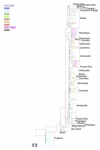A phylogenetic analysis using full-length viral genomes of South American dengue serotype 3 in consecutive Venezuelan outbreaks reveals a novel NS5 mutation
- PMID: 21964598
- PMCID: PMC3565618
- DOI: 10.1016/j.meegid.2011.09.010
A phylogenetic analysis using full-length viral genomes of South American dengue serotype 3 in consecutive Venezuelan outbreaks reveals a novel NS5 mutation
Abstract
Dengue virus currently causes 50-100 million infections annually. Comprehensive knowledge about the evolution of Dengue in response to selection pressure is currently unavailable, but would greatly enhance vaccine design efforts. In the current study, we sequenced 187 new dengue virus serotype 3 (DENV-3) genotype III whole genomes isolated from Asia and the Americas. We analyzed them together with previously-sequenced isolates to gain a more detailed understanding of the evolutionary adaptations existing in this prevalent American serotype. In order to analyze the phylogenetic dynamics of DENV-3 during outbreak periods; we incorporated datasets of 48 and 11 sequences spanning two major outbreaks in Venezuela during 2001 and 2007-2008, respectively. Our phylogenetic analysis of newly sequenced viruses shows that subsets of genomes cluster primarily by geographic location, and secondarily by time of virus isolation. DENV-3 genotype III sequences from Asia are significantly divergent from those from the Americas due to their geographical separation and subsequent speciation. We measured amino acid variation for the E protein by calculating the Shannon entropy at each position between Asian and American genomes. We found a cluster of seven amino acid substitutions having high variability within E protein domain III, which has previously been implicated in serotype-specific neutralization escape mutants. No novel mutations were found in the E protein of sequences isolated during either Venezuelan outbreak. Shannon entropy analysis of the NS5 polymerase mature protein revealed that a G374E mutation, in a region that contributes to interferon resistance in other flaviviruses by interfering with JAK-STAT signaling was present in both the Asian and American sequences from the 2007-2008 Venezuelan outbreak, but was absent in the sequences from the 2001 Venezuelan outbreak. In addition to E, several NS5 amino acid changes were unique to the 2007-2008 epidemic in Venezuela and may give additional insight into the adaptive response of DENV-3 at the population level.
Published by Elsevier B.V.
Figures




Similar articles
-
Evolution of dengue virus type 3 genotype III in Venezuela: diversification, rates and population dynamics.Virol J. 2010 Nov 18;7:329. doi: 10.1186/1743-422X-7-329. Virol J. 2010. PMID: 21087501 Free PMC article.
-
Molecular epidemiology of dengue virus type 3 in Venezuela.J Gen Virol. 2003 Jun;84(Pt 6):1569-1575. doi: 10.1099/vir.0.18807-0. J Gen Virol. 2003. PMID: 12771427
-
Complete genome sequencing and evolutionary analysis of dengue virus serotype 1 isolates from an outbreak in Kerala, South India.Virus Genes. 2012 Aug;45(1):1-13. doi: 10.1007/s11262-012-0756-3. Epub 2012 May 22. Virus Genes. 2012. PMID: 22729802
-
Specific genetic markers for detecting subtypes of dengue virus serotype-2 in isolates from the states of Oaxaca and Veracruz, Mexico.BMC Microbiol. 2008 Jul 15;8:117. doi: 10.1186/1471-2180-8-117. BMC Microbiol. 2008. PMID: 18625078 Free PMC article.
-
Molecular Characterization of Dengue Virus Serotype 2 Cosmospolitan Genotype From 2015 Dengue Outbreak in Yunnan, China.Front Cell Infect Microbiol. 2018 Jun 27;8:219. doi: 10.3389/fcimb.2018.00219. eCollection 2018. Front Cell Infect Microbiol. 2018. PMID: 29998087 Free PMC article.
Cited by
-
Population structure of the dengue viruses, Aragua, Venezuela, 2006-2007. Insights into dengue evolution under hyperendemic transmission.Infect Genet Evol. 2012 Mar;12(2):332-44. doi: 10.1016/j.meegid.2011.12.005. Epub 2011 Dec 17. Infect Genet Evol. 2012. PMID: 22197765 Free PMC article.
-
Dengue: a growing menace -- a snapshot of recent facts, figures & remedies.Int J Biomed Sci. 2013 Jun;9(2):61-7. Int J Biomed Sci. 2013. PMID: 23847455 Free PMC article.
-
Dengue virus type 3 adaptive changes during epidemics in São Jose de Rio Preto, Brazil, 2006-2007.PLoS One. 2013 May 7;8(5):e63496. doi: 10.1371/journal.pone.0063496. Print 2013. PLoS One. 2013. PMID: 23667626 Free PMC article.
-
Dengue in Latin America: Systematic Review of Molecular Epidemiological Trends.PLoS Negl Trop Dis. 2017 Jan 9;11(1):e0005224. doi: 10.1371/journal.pntd.0005224. eCollection 2017 Jan. PLoS Negl Trop Dis. 2017. PMID: 28068335 Free PMC article. Review.
-
Intra-epidemic evolutionary dynamics of a Dengue virus type 1 population reveal mutant spectra that correlate with disease transmission.Sci Rep. 2016 Mar 4;6:22592. doi: 10.1038/srep22592. Sci Rep. 2016. PMID: 26940650 Free PMC article.
References
-
- Aquino JD, Tang WF, Ishii R, Ono T, Eshita Y, Aono H, Makino Y. Molecular epidemiology of dengue virus serotypes 2 and 3 in Paraguay during 2001-2006: the association of viral clade introductions with shifting serotype dominance. Virus research. 2008;137:266–270. - PubMed
-
- Aquino VH, Anatriello E, Goncalves PF, EV DAS, Vasconcelos PF, Vieira DS, Batista WC, Bobadilla ML, Vazquez C, Moran M, Figueiredo LT. Molecular epidemiology of dengue type 3 virus in Brazil and Paraguay, 2002-2004. The American journal of tropical medicine and hygiene. 2006;75:710–715. - PubMed
-
- Araujo JM, Bello G, Schatzmayr HG, Santos FB, Nogueira RM. Dengue virus type 3 in Brazil: a phylogenetic perspective. Memorias do Instituto Oswaldo Cruz. 2009a;104:526–529. - PubMed
Publication types
MeSH terms
Grants and funding
LinkOut - more resources
Full Text Sources
Medical
Research Materials

